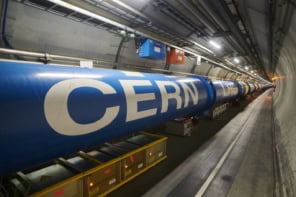Clever Dick
Crispin Whittell
23 May 2006
The Hampstead Theatre, London

It’s 17 June 1945. We are in a sleazy hotel room in the middle of nowhere: Socorro, New Mexico to be precise. One by one, four characters stumble in: Dick or Richard or Ritty – or is it Feynman, Feinstein or Fuchs? – who has not slept for 58 hours; a bouncy 18 year old, Matilda, who knows lots about frogs; a “fat man” straight out of central casting for a 1940s gumshoe; and a “little boy”, name of Billy (or is it Conrad, or maybe Nicky?). The stage is set for a smoke-and-mirrors production about what goes on at that mysterious place the locals call “the hill”.
Clever Dick, written and directed by Crispin Whittell, is an imaginative fictional gathering that pokes fun at the security-crazy world of the Manhattan Project, or perhaps anywhere these days. Terry Johnson’s Insignificance and Michael Frayn’s Copenhagen immediately leap to mind. As in Insignificance, in which Albert Einstein, Marilyn Monroe, Senator Joe McCarthy and Joe DiMaggio end up in a hotel room in Times Square, the looming unseen presence is Einstein’s iconic equation, E = mc2. But whereas the plays of Johnson and Frayn explored serious social and scientific issues, Whittell’s offering is more like a Ben Elton slapstick – involving mistaken identities, a frog that gets shot and a nun on a trampoline.
The sobriquets “fat man” and “little boy” appear only in the cast list, not the play itself. Unless you already know their meaning, you will miss whatever significance the playwright intended. In real life, “Fat Man” was a spherically shaped bomb with an implosion mechanism to compress a sphere of plutonium and blow it up. In the play, Fat Man (Corey Johnson) is a rotund, bumbling counter-intelligence agent zealously trying to ferret out commie spies and help blast “the yella fellas”. “Little Boy” – the sleek, cylindrical bomb containing a uranium gun that was detonated over Hiroshima – is the playboy Nicky Hilton (Jamie King), best known today as the grandfather of It-girl Paris.
Nicky and Dick are the only two non-fictional characters in the play. In real life, Dick (Adrian Rawlins) – the physicist Richard Feynman – was back at Los Alamos (“the hill”) that night, sorely depressed over his wife’s death the day before, while Hilton was in the South Pacific on the battleship USS North Carolina.
Though not portrayed in the play, the nuclear physicist Klaus Fuchs also looms large. Fuchs was a brilliant and popular scientist who liked to joke that if there was a spy at Los Alamos, it was probably Feynman since he was constantly away (in fact he was visiting his dying wife). But it was Fuchs who was revealed as a Soviet spy in 1949. His handler was Harry Gold, an American industrial chemist, and together they delivered a wealth of information to the Russians, including the design of “Fat Man”.
Back in the world of Clever Dick, Fuchs is suspected of spying and the Keystone cop is on the trail of his blue Buick, which Feynman has happened to borrow. In the course of climbing in and out of various hotel rooms, Matilda (Jennifer Higham) tells Feynman that a Mr Gold (“He talks funny too. He talks like you.”) is in the next room. This clinches it for the dick that Dick is Fuchs, setting up a classic case of mistaken identity.
The play is well acted and funny, with an imaginative stage set and nostalgic 1940s swing music. I am happy to report that the physics, though sparse, is interesting. “Everybody’s heard of it, which isn’t the same as knowing what it means,” says Matilda aptly to Feynman about E = mc2. Feynman encourages her inquisitiveness, telling her that he too is in a state of constant confusion. If “a lump of radioactive stuff” gives off a lot of energy, she wonders, and if c is a small number, then a lot of mass is lost too. “But it isn’t, is it? It comes down to the c, doesn’t it,” she concludes correctly.
Then Matilda asks the $64,000 question: “Why did he [Einstein] choose the speed of light?” “Who knows? I don’t know. Albert possibly knows. But it’s also possible that he doesn’t, precisely. I’m guessing it was a guess,” replies Feynman, in Feynmanese, reminding us of the cartoon in which Einstein writes “E = ma2” on a blackboard, crosses it out and writes under it “E = mb2“. The real Feynman would have said to luscious Matilda that “c is in E = mc2 because of Einstein’s method for synchronizing clocks using light signals. And here’s how that goes, babe…”.
My New York Bronx ear detected Feynman speaking Brooklynese, not Long Islandese. But this is just hair-splitting for a UK audience. Could you imagine an American actor doing Wayne Rooney? Feynman is presented undeservedly as a geeky scientist, and the actor playing him is a bit long in the tooth for someone who was at that time a very young-looking 27 year old. All in all, this is a play for which that hackneyed caveat emptor holds: any coincidence with characters living or dead is purely coincidental.



